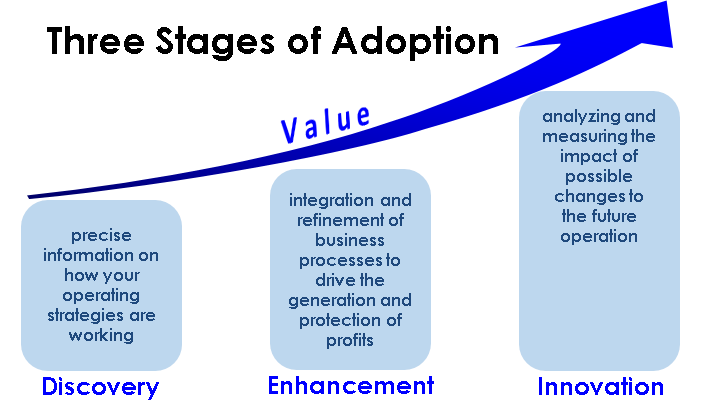Data Governance is vital
According to Forbes, 78% of executives reported that business intelligence (BI) Data Governance is either vital or important to their operations
In the current context of BI and its evolution, it is important that every business understands the governance of data. Data governance is an important aspect of business that aims to provide greater control over the creation, manipulation, support, storage, use, and sharing of critical information. A key component of any data quality or information management strategy, data governance is more than just a software solution. It requires the combination of people, rules, procedures and underlying technologies to succeed.
BI governance brings together a set of people, processes and tools that will enable the different actors to bring business intelligence to the organization. It goes without saying that this subject is important, but it is far from easy to tackle. Yet this is an important factor that maximizes the adoption of BI solutions.
Data governance permanently enhances data quality
In our modern and highly interconnected world, we constantly need to consider new data sources. As storage capacities continue to increase, organizations today are able to deliver on the promise of Big Data: more efficient and automated production processes, more targeted marketing, and smarter, data-driven decisions. But how are the processes in organizations to be designed to achieve these goals? In addition to using innovative IT systems, companies need to fundamentally rethink how they deal with information and the issue of data quality. Data Governance is an approach that strategically implements this rethinking.

Data governance refers to different disciplines of data management. They all aim to make the data consistent and usable, without users having to think about where the data came from or whether it might have been manipulated. Data governance ensures that data is trusted, accurate, consistent, secure, and available throughout its life-cycle.

New handling of data
To implement this strategy, a new understanding of the data is necessary. What is required is a new approach to data, which requires a cross-departmental view of the data. For a data governance initiative, employees should collaborate interdisciplinary and functionally to achieve, for example, a company-wide understanding of the task.
Experts believe that the key to successful data management lies in a consistent data governance strategy. A survey of financial services provider State Street out of 400 senior executives in global investment organizations has shown that only 37 percent are professionally improving data quality with a data governance initiative. The reason: the implementation of these measures can lead to a complex project. Because just as data can now be found in almost every work process, its quality control should also be continuously effective. Implementing a data governance initiative involves not just the IT department, but the entire organization. Nevertheless, even without the legal requirements, there are many reasons for this investment.
Benefits of Data Governance
However, data governance can also make sense for better customer orientation. Due to the large number of communication channels, customers often appear omnipresent, but are therefore also difficult to access. Standardized data management contributes to the clarity of information. Instead of an abundance of information, data helps to understand the customer and his behavior. And who understands his customers, can respond better to them.
Holistic data governance also increases the long-term efficiency of a company. Ordered data, for example, allow analysis that highlights vulnerabilities. As a result, operating costs can be reduced or room for innovation can be found. And that can compensate for the original effort.

Adoption and BI governance
To facilitate extended data governance across the enterprise, many organizations designate data stewards to audit information management efforts. These data managers are often fully responsible for defining, implementing, and enforcing standards and policies that will ensure the continued quality of information across all systems and data sources. Companies that have successfully implemented data governance strategies generally see an improvement in the accessibility, accuracy, completeness, and usability of the company’s information capital.
Although data governance plans are important for organizations of all types and sizes, they become particularly critical as the amount of data generated and the number of sources from which they come and reside increases.
Businesses facing “big data” all the more need to set up formalized data governance programs and effective but agile technologies to support these strategies. With data governance, they can maintain the integrity of the extraordinary amount of information that exists within their different network of systems.
Business intelligence technologies are at the heart of this transformation process. It is no longer a question of proposing here and there a few schema that are supposed to synthesize a reporting chain, but rather of managing the information capital. The performance and quality of the management of this heritage, because that is what it is all about, will be the keystone of all future technological projects. business intelligence departments ( context, it is easy to understand the frustration of the users. It’s also easy to understand why business intelligence departments” have such a hard time getting recognized.
Implementation of data governance
Data security
The issue of data security is inseparable, at least in terms of the issues to be addressed, from issues of confidentiality. In all cases, a trace-ability program for essential data must be implemented.
Reliability of data
Ensuring an acceptable level of reliability of the data to be collected is not the least of the priority issues to be addressed by data governance. In any case, all these questions will be developed and declined before being asked and resolved as soon as possible, from the very beginning of the project.

Let’s go: the first steps
When implementing a data governance initiative, the distribution of responsibilities should first be clarified. Who controls the implementation? Who is actually responsible for quality assurance later? How is the project financed? Once these questions have been clarified, the participants are defined from the entire organization - this group can therefore be very large.
The most important aspect during the implementation is therefore the binding communication within the team. Analyzes afterwards ensure that quality control is effective. These should also be repeated later as the monitored processes change continuously. Precisely because the implementation of data governance is a complex process, it makes sense to proceed step by step.
So it’s not just about introducing specific technologies. Rather, the employees should also have a new and shared understanding of the value of the data. This also includes the ongoing maintenance of this data. If employees manage to train appropriately, they already contribute to good data quality in their day-to-day work processes.





Comments